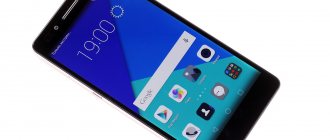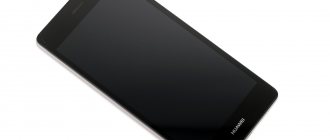It’s easier to get confused in the family tree of Huawei/Honor smartphones than in the pedigree of some Habsburgs: smartphones alone that bear the title of flagships can be counted at two or three for each brand. Honor annually falls under this title with a “numbered” model (at the time of publication it is Honor 10), which is then replaced in this position by the View series smartphone - with the latest platform and developments applied in the main smartphone of the Chinese company - Huawei Mate. But there is also Honor Magic2, which, in addition to the Kirin 980 system-on-chip, offers almost absolute framelessness due to the use of a slider mechanism.
The same hole with the front camera
The “magic” smartphone, however, never went beyond the Chinese market, so Honor View 20 can be considered the official international flagship of the brand, which has its own way to get rid of the hateful “unibrow” - this is one of the first devices with a hole in the corner screen where the front camera is inserted. Officially, the first two smartphones with a similar solution were Huawei nova 4 and Samsung Galaxy A8s, but View 20 is not that far behind.
| Two color options for the standard version: Mystic Black and Sapphire Blue | ||
This is not the only advantage of the new gadget. It is built on the basis of the most powerful Huawei platform - HiSilicon Kirin 980 with a special cooling system, is equipped with a dual rear camera with a main module, the declared resolution of which is as much as 48 megapixels, has three Wi-Fi antennas and a dual-frequency GPS module, as well as some superpowers associated with the use of an additional 3D camera.
⇡#Technical characteristics
| Honor View 20 | Honor 10 | Xiaomi Mi 8 | OnePlus 6T | Oppo RX17 Pro | |
| Display | 6.4 inches, IPS, 2310 × 1080 pixels, 398 ppi, capacitive multi-touch | 5.84 inches, IPS, 2280 × 1080 pixels, 432 ppi, capacitive multi-touch | 6.21 inches, AMOLED, 2246 × 1080 pixels, 402 ppi, capacitive multi-touch | 6.41 inches, AMOLED, 2340 × 1080 pixels, 402 ppi, capacitive multi-touch | 6.4 inches, AMOLED, 2340 × 1080 pixels, 401 ppi, capacitive multi-touch |
| Protective glass | Corning Gorilla Glass (version unknown) | Corning Gorilla Glass (version unknown) | Corning Gorilla Glass 5 | Corning Gorilla Glass 6 | Corning Gorilla Glass 6 |
| CPU | HiSilicon Kirin 980: eight cores (2 × ARM Cortex A76, 2.6 GHz frequency + 2 × ARM Cortex A76, 1.92 GHz frequency + 4 × ARM Cortex A55, 1.8 GHz frequency); HiAI architecture | HiSilicon Kirin 970: four ARM Cortex A73 cores, 2.4 GHz + four ARM Cortex A53 cores, 1.8 GHz; HiAI architecture | Qualcomm Snapdragon 845: four Kryo 385 Gold cores, 2.8 GHz + four Kryo 385 Silver cores, 1.7 GHz | Qualcomm Snapdragon 845: four Kryo 385 Gold cores, 2.8 GHz + four Kryo 385 Silver cores, 1.7 GHz | Qualcomm Snapdragon 710: two Kryo 360 Gold cores, 2.2 GHz + six Kryo 360 Silver cores, 1.7 GHz |
| Graphics controller | ARM Mali-G76 MP10, 720 MHz | ARM Mali-G72 MP12, 850 MHz | Adreno 630, 710 MHz | Adreno 630, 710 MHz | Adreno 616, 750 MHz |
| RAM | 6/8 GB | 4 GB | 6 GB | 6/8/10 GB | 6 GB |
| Flash memory | 128/256 GB | 64/128 GB | 64/128/256 GB | 128/256 GB | 128 GB |
| Memory card support | No | No | No | No | Eat |
| Connectors | USB Type-C, 3.5 mm mini-jack | USB Type-C, 3.5 mm mini-jack | USB Type-C | USB Type-C | USB Type-C |
| SIM cards | Two nano-SIMs | Two nano-SIMs | Two nano-SIMs | Two nano-SIMs | Two nano-SIMs |
| Cellular connection 2G | GSM 850/900/1800/1900 MHz | GSM 850/900/1800/1900 MHz | GSM 850/900/1800/1900 MHz | GSM 850/900/1800/1900 MHz CDMA 800/1900 | GSM 850/900/1800/1900 MHz |
| Cellular 3G | HSDPA 850 / 900 / 1700 / 1900 / 2100 MHz | HSDPA 850 / 900 / 1900 / 2100 MHz | UMTS 850 / 900 / 1900 / 2100 | HSDPA 800 / 850 / 900 / 1700 / 1800 / 1900 / 2100 MHz | WCDMA 800 / 850 / 900 / 1700 / 1900 / 2100 MHz |
| Cellular 4G | LTE Cat. 13 (up to 400 Mbit/s): bands 1, 2, 3, 4, 5, 6, 7, 8, 19, 20, 28, 38, 39, 40, 41 | LTE Cat. 13 (up to 400 Mbit/s): bands 1, 3, 5, 6, 7, 8, 19, 20, 38, 40, 41 | LTE Cat. 16 (up to 1024 Mbit/s): bands 1, 3, 4, 5, 7, 8, 20, 34, 38, 39, 40, 41 | LTE Cat.16 (up to 1024 Mbps): bands 1, 2, 3, 4, 5, 7, 8, 12, 13, 17, 18, 19, 20, 25, 26, 28, 29, 30, 32 , 34, 38, 39, 40, 41, 46, 66, 71 | LTE Cat.15 (up to 800 Mbps): bands 1, 2, 3, 4, 5, 7, 8, 12, 17, 18, 19, 20, 25, 26, 28, 32, 34, 38, 39 , 40, 41 |
| WiFi | 802.11a/b/g/n/ac | 802.11a/b/g/n/ac | 802.11a/b/g/n/ac | 802.11a/b/g/n/ac | 802.11a/b/g/n/ac |
| Bluetooth | 5.0 | 4.2 (aptX HD) | 5.0 | 5.0 | 5.0 |
| NFC | Eat | Eat | Eat | Eat | Eat |
| Navigation | GPS, A-GPS, GLONASS, BeiDou, Galileo | GPS, A-GPS, GLONASS, BeiDou | GPS, A-GPS, GLONASS, BeiDou | GPS, A-GPS, GLONASS, BeiDou, Galileo | GPS, A-GPS, GLONASS, BeiDou, Galileo |
| Sensors | Light, proximity, accelerometer/gyroscope, magnetometer (digital compass), IR sensor | Light, proximity, accelerometer/gyroscope, magnetometer (digital compass), IR sensor | Illumination, proximity, accelerometer/gyroscope, magnetometer (digital compass) | Illumination, proximity, accelerometer/gyroscope, magnetometer (digital compass) | Illumination, proximity, accelerometer/gyroscope, magnetometer (digital compass) |
| Fingerprint's scanner | Eat | Eat | Eat | Yes, on the screen | Yes, on the screen |
| Main camera | Dual module, 48 MP, ƒ/1.8 + 3D-TOF camera, phase detection autofocus, LED flash | Dual module, 24 + 16 MP, ƒ/1.8, phase detection autofocus, LED flash | Dual module, 12 MP, ƒ/1.8 + 12 MP, ƒ/2.4, phase detection autofocus, optical stabilization (with main camera) | Dual module, 16 + 20 MP, ƒ/1.7 + ƒ/1.7, hybrid autofocus, dual LED flash | Dual module, 12 + 20 MP, ƒ/1.5-2.4 + ƒ/2.6, phase detection autofocus, optical stabilization, LED flash |
| Front-camera | 25 MP, ƒ/2.0, fixed focus | 24 MP, ƒ/2.0, fixed focus | 20 MP, ƒ/2.0, fixed focus | 16 MP, ƒ/2.0, fixed focus | 25 MP, ƒ/2.0, fixed focus |
| Nutrition | Non-removable battery: 15.2 Wh (4000 mAh, 3.8 V) | Non-removable battery: 12.92 Wh (3400 mAh, 3.8 V) | Non-removable battery: 12.92 Wh (3400 mAh, 3.8 V) | Non-removable battery: 14.06 Wh (3700 mAh, 3.8 V) | Non-removable battery: 14.06 Wh (3700 mAh, 3.8 V) |
| Size | 156.9 × 75.4 × 8.1 mm | 149.6 × 71.2 × 7.7 mm | 154.9 × 74.8 × 7.6 mm | 157.5 × 74.8 × 8.2 mm | 157.6 × 74.6 × 7.9 mm |
| Weight | 180 grams | 153 grams | 175 grams | 185 grams | 183 grams |
| Housing protection | No | No | No | No | No |
| operating system | Android 9.0 Pie, EMUI shell | Android 8.1 Oreo, EMUI shell | Android 8.1.0 Oreo, MIUI shell | Android 9.0 Pie, OxygenOS shell | Android 8.1 Oreo, ColorOS shell |
| Current price | 37,990 rubles for the 6/128 GB version, 44,990 rubles for the 8/256 GB version | 24,990 rubles for the 4/64 GB version, 25,700 rubles for the 4/128 GB version | 27,490 rubles for the 6/64 GB version, 28,990 rubles for the 6/128 GB version, 28,150 rubles for the 6/256 GB version | 35,260 rubles for the 6/128 GB version, 37,800 rubles for the 8/128 GB version, 45,250 rubles for the 8/256 GB version | 49,990 rubles |
| Honor View 20 – information about the filling according to the CPU-Z application | ||||
Cameras
The View 10 smartphone received a dual camera, the main module of which has a resolution of 16 megapixels, and the second - black and white - has 20 megapixels. Two cameras - color and black and white - combine photos taken separately into one, and the result is a photo with minimal noise and a wide dynamic range. In addition, the neural network module improves autofocus and face detection, and controls other less noticeable functions that improve images.
Daytime photos are of the highest quality, and the HDR mode works more than properly. As a result, we have almost perfect photographs. In addition, there is a background blur mode, which gives an interesting effect to the photo.
It is worth adding about the presence of a real 2x zoom, which is carried out without loss of photo quality. The main feature of the rear camera is that even in poor lighting or at night, the pictures are of good quality. Overall, the camera turned out to be quite good without any noticeable disadvantages.
And the 13 megapixel front camera can’t boast of anything special. The pictures come out quite good, you don’t need more for a selfie camera.
The “Camera” application turned out to be intuitive and has just a huge number of settings: from ready-made options to manual fine adjustments.
The video from the front and main cameras is of good quality and high resolution, up to 4K at 30 frames per second.
⇡#Appearance, ergonomics and software
For the first time, a cutout in the middle of the status bar appeared in September 2017 - with the release of the iPhone X. It seems that a little more than a year has passed, and this technique of increasing the usable screen area, having been copied by everyone, has become very boring. It is no wonder that manufacturers gradually began to look for various options to abandon the “unibrow”, while somehow trying to maintain the ratio of the screen area to the front panel area as high as possible.
Red version of the Moschino version - note the branded wallpaper
In principle, there are many ways: you can make different versions of a sliding smartphone (Vivo NEX, OPPO Find X, Xiaomi Mi MIX 3, Honor Magic2), insert a second screen on the back panel (Vivo NEX Dual Display, nubia X) or move the “front” from the cutout to some other area. The latter option is used in Honor View 20. The lens, in fact, is built directly into the display - and it also eats away a small part of the status bar, but this is not as noticeable as on a smartphone with a cutout, even a very small one, such as, for example, in Huawei Mate 20 or OnePlus 6T. At first glance, this black hole in the upper left corner of the screen may hurt the eye, but, firstly, you quickly get used to it, and secondly, this solution is in any case fresher than the boring cutout.
Honor View 20, front panel: in the upper left corner there is a front camera, right under the top edge there is a thin slot for the earpiece
The display itself is a classic format for a modern high-status smartphone: 6.4-inch diagonal, aspect ratio 19.5:9. The frames are minimal both on the sides, top and bottom. But it’s still not worth talking about their complete absence, official “framelessness”. In addition, despite all the tricks, the screen itself does not become smaller - the View 20 is much larger than the Honor 10, it is a hefty smartphone that can only be operated with one hand using various software tricks, such as moving the reduced desktop to one of the corners.
Honor View 20, rear panel: in the upper left corner there is a block of two cameras and a single LED flash, in the center there is a fingerprint scanner
The back panel is made of polished glass - all in the traditions of Honor (established almost three years ago, in the eighth version), the back of the smartphone can be used as a colored mirror. The individuality of the model is emphasized by a special polishing in the shape of the letter V - so that no one forgets that you have not just Honor, but the eldest of them. The brand name, by the way, is also spelled out at the back – and in a fresh font that was rebranded at the end of last year. The smartphone shimmers in the light very beautifully – this time in a special way. It’s worth mentioning the gradient coloring used once again – it also looks good. The View 20 may not be the most beautiful smartphone in the world (it’s a little thick), but it’s clearly on the list of contenders for this title.
Honor View 20, left side: slot for two nano-SIM cards
Honor View 20, right side: power key and volume key/camera shutter release
The back is curved towards the edges - holding the smartphone is quite comfortable. But all the complaints typical of glass gadgets with curved edges apply here too - the device is slippery, it’s easy to drop it from a wet hand, and it also tends to crawl away from an insufficiently flat surface. Be careful and use a case (a simple transparent one is included).
Honor View 20, top edge: mini-jack, microphone, IR sensor and light sensor
Honor View 20, bottom: USB Type-C port, main speaker and microphone
Honor View 20 is available in two colors – blue and black. There is also a version of Honor View 20, released in collaboration (or, as we can now say, collaboration) with the fashion house Moschino - it is presented in red and blue colors and features special wallpapers and themes, as well as increased memory capacity (8/256 GB ). This is exactly what we tested, but without the pre-installed Moschino wallpaper.
The edges are made of aluminum, dotted with plastic inserts for the correct operation of numerous antennas, and sensors. There are no surprises with the functional elements: there is both a mini-jack and a USB Type-C port and a fingerprint scanner located in the old fashioned way on the rear panel.
The scanner is capacitive, works very quickly - it surpasses all modern screen sensors. Among the shortcomings, one can only note the inability to unlock the smartphone with one hand when it is lying on the table. But you can look into the abyss of its front camera - the abyss will look back at you and try to recognize your face. It does this quite successfully, but it does not use additional recognition tools such as building a 3D model or scanning the retina, meaning someone will only need your photo to unlock the phone.
Screenshot gallery
View all images (22)The operating system is Android 9.0 Pie with the proprietary Magic UI 2.0.1 shell. This is a version of the traditional Huawei EMUI shell, developed specifically for Honor smartphones. I talked about it in more detail in the review of Honor Magic2, but in the international version it is almost no different from EMUI - except that the themes and wallpapers are different, and instead of Huawei service applications, Honor applications are installed here. In China, it integrates a very smart voice assistant, YoYo, which works closely with various Chinese services and can recognize the owner’s voice at a very high level. It is unknown when it will appear in Russia and reveal the potential of Magic UI. Without it, it is a rather simple, unobtrusive, but overcrowded shell with proprietary applications (in my opinion, too much), with a pre-installed Yandex search on the second screen, Alice built into the notification panel and the Yandex browser as the main one. Almost “Yandex.Phone” (of a healthy person).
Someone may have questions about how that very hole is inscribed in the software shell - Android has just gotten used to cutouts, and here is a new trend. I hasten to answer them and dispel doubts - there are no problems, in applications it simply fits into the status bar and does not in any way interfere with the perception of information from the screen. Problems can occur in games, but quite rarely: due to the spread of the notch, the interface is created with a pre-defined free zone at the edge of the screen, which includes both a possible “notch” and a hole for the camera, as here.
Design and ergonomics
The smartphone is available in four colors:
- black;
- blue;
- red;
- blue.
They brought us the red version, which effectively shimmers into a dark burgundy color.
Let's start right away with the main thing - the hole in the smartphone display, which houses the front camera and the necessary sensors. In 2021, “eyebrows” and “drops” were popular, but now this solution is the future.
The compact round cutout is located in the upper left corner and attracts all attention from the first use. At first it looks unusual, but over time you quickly get used to it.
For perfectionists, it should be located asymmetrically relative to the curvature of the screen, but slightly to the right.
If for some reason you don’t like this solution, the cutout in the display can be hidden programmatically in the device settings - the top panel will turn black and the front camera module will be almost invisible. In this case, the status bar and all the shortcuts will remain at the top, which is very convenient.
In the frame above the screen, the developers hid the earpiece, which is almost invisible during everyday use of the phone.
The frames around the screen are miniature, so the usable display area is very large. The corners of the screen are rounded.
All navigation buttons are touch sensitive and are located on the screen. This is a familiar and convenient solution, because physical buttons require space off the screen, and here there is simply none.
Let's move on to the back glass panel of the smartphone. Honor designers know a lot about this - just remember the beautiful iridescent Honor 10. The tested smartphone uses a similar solution, only the back cover in the shape of the letter “V” is iridescent.
There is a strange dual camera in the top left corner. The first camera module is located on the same “platform” with the flash, the second (main) is separate, and it is more convex. This solution does not look very harmonious.
In the center of the back, the designers placed the usual slightly recessed fingerprint scanner, and at the bottom is the “Honor” logo.
The volume and power buttons are located on the right side of the device - a proven and convenient place.
On the left, the developers have placed a tray for SIM cards and NanoSD memory cards. The slot is hybrid, so the new memory card format takes the place of one of the nanoSIMs.
A modern USB Type-C charging connector is located in the center of the bottom edge. Nearby you can find the main speaker, conversational microphone and antenna strips.
The developers also left a headphone jack (3.5 mm) - it is located on the top end of the smartphone. There is also noise reduction and two infrared ports at once.
A matte, metallic and rounded edge runs along the perimeter of the gadget, making it convenient and comfortable to hold the smartphone in your hand.
In terms of ergonomics, Honor View 20 is similar to all glass flagship smartphones - it is beautiful and pleasant to the touch, but slippery.
The smartphone cannot be called easily soiled - the back perfectly resists the collection of fingerprints and greasy marks, and the display is covered with a high-quality oleophobic coating.
⇡#Display and sound
Creating a middle-class smartphone (okay, “upper middle class”), which surpasses last year’s flagship Huawei P20 Pro in power and partly in functionality, the manufacturer had to give up something - otherwise it would have turned out to be a full-fledged internal competitor for a gadget that was already gradually leaving the scene from last season, and for the fresh Mate 20/Mate 20 Pro, which is based on the same Kirin 980 platform. This something was the display - instead of the OLED that is already usual for all flagships, there is a liquid crystal screen with an IPS matrix.
The diagonal was 6.4 inches, the resolution was 2310 × 1080 pixels with a pixel density of 398 ppi. The detail is far from extreme, which can be seen on 4K video. There will be no problems when reading from the screen and viewing photos. The matrix is of high quality - viewing angles are free, when the view is deviated to a serious angle, the contrast is slightly lost, but the colors are not distorted at all. The touch coating responds to 10 simultaneous touches. But the oleophobic coating is not very good - such a sin is common with Huawei or Honor smartphones. By default, a protective film is glued to your smartphone - it is better not to remove it for as long as possible. The defenseless screen gets dirty easily and is quite difficult to wipe off.
The measured maximum brightness level is 447 cd/m2 - the average for an LCD matrix; you cannot count on ideal comfort when using a smartphone on a sunny day outside. The image will be visible, the display will not go blind, but it will not be able to maintain full color.
The contrast level is 1171:1. Quite normal for IPS.
In the screen settings, you can turn on eye protection (a mode with the warmest colors), change the resolution or font size, and adjust the color rendering - choose between two profiles (normal and bright) or set the color temperature you need. I measured color rendering in exactly two preset profiles, without individual temperature adjustment. Among other screen settings, I’ll note the ability to fill the status bar with black, which is typical for smartphones with a cutout, and not with a front-facing camera-in-a-hole. But if you are annoyed by the black circle in the corner, you can get rid of it in this simple way.
Honor View 20, gamma in normal color mode. Yellow line – View 20 indicators, dotted line – reference gamma
Honor View 20, color temperature in normal color mode. Blue line – View 20 indicators, dotted line – reference temperature
Honor View 20, color gamut in normal color mode. Gray triangle – sRGB coverage, white triangle – View 20 coverage
In normal color rendering mode, the gamma is 2.05 - the curves are stable in dark shades, the gamma drops noticeably in light shades. The color temperature curve is stable, staying around 7,700 K. The average deviation for the extended Color Checker palette (shades of gray + a wide range of color shades) is 3.57, with an upper limit of 3.00. However, this result is better than the hospital average. The color gamut is almost equal to sRGB. The screen in this mode is set up very well, but you can improve the situation by slightly manually adjusting the color temperature.
Honor View 20, gamma in bright color mode. Yellow line – View 20 indicators, dotted line – reference gamma
Honor View 20, color temperature in vivid color mode. Blue line – View 20 indicators, dotted line – reference temperature
Honor View 20, color gamut in vivid color mode. Gray triangle – sRGB coverage, white triangle – View 20 coverage
In bright mode, Honor View 20 expands the color gamut - from sRGB to DCI-P3, increases the color temperature (the line is already uneven, jumping from 8,200 to 11,000 K), there is no need to talk about accuracy - the average deviation Delta E on the Color Checker scale is 7.42. The picture is frankly cold, rich, but very far from natural.
The Honor View 20's sound is not bad, but not great. On the plus side, I note the presence of a mini-jack - owners of wired headphones do not need to use an adapter and can even listen to music with them while charging their smartphone! Unprecedented luxury in modern times. The quality of sound transmission over the wires will be fine - although not outrageous, I was slightly lacking in detail and power reserves. If you are leaving the wired world in any case, there is support for aptX HD. The speaker is monophonic, located on the bottom edge, its volume is enough so that you don’t miss a call or hear what another blogger is broadcasting on Youtube. Listening to music or watching a movie without headphones or external speakers is not very pleasant.
⇡#Hardware and performance
Honor View 20 is the next (third) Huawei smartphone based on the company’s main platform, HiSilicon Kirin 980. It consists of eight cores, arranged in a more whimsical order than big.LITTLE: two ARM Cortex-A76 with a clock frequency of 2.6 GHz + two more ARM Cortex-A76 clocked at 1.92 GHz + four ARM Cortex-A55 clocked at 1.8 GHz. Graphics subsystem – ARM Mali-G76 MP10 with a clock frequency of 720 MHz. Technological process – 7 nm. According to Huawei, this is the world's first commercial platform using the 7nm process technology. In fact, they and the Apple A12 Bionic came out, essentially, at the same time: if HiSilicon was simply announced first, then Apple released smartphones with its 7nm system a little earlier than Huawei.
In terms of pure performance, the Kirin 980 does not set any records - it is inferior to both the A12 Bionic and the fresh flagship Qualcomm Snapdragon 855 platform, approximately equal in power to last year's (officially the year before) Snapdragon 845. This is enough to run any modern games without problems, lose 4K video and provide a performance reserve for several years to come, but those who like to compare “parrots” have nothing to rejoice at.
If the immediate performance is good (but not brilliant), then with stability everything is a little more sad - like the Huawei Mate 20 Pro with Honor Magic2, the smartphone passes the CPU Throttling Test benchmark uncertainly, with the frequency decreasing to 55% of the maximum. But the average performance is 179 GIPS. I continue to argue that the problem is not primarily in the cooling (the smartphone remains, if not cold, then certainly not overheated), but in the controllers. Moreover, Huawei is obviously working on this - the average performance in this benchmark is growing from smartphone to smartphone with Kirin 980: 132 GIPS for the Mate 20 Pro, 153 GIPS for the Magic2 and now, 179 GIPS. But the frequencies jump and drop towards the end of the 15-minute test. Therefore, I cannot just routinely praise the Honor View 20 for installing a patented cooling system (with its own name - NINE Cooling Technology), the smartphone has problems in this area.
What the new platform is undeniably good at is operations that leverage machine learning. There are not many of them yet, this is not the key specification by which a mobile platform should be evaluated, but we are already testing smartphones using this parameter. The Kirin 980 easily beats the Qualcomm Snapdragon 845 here - with a more than twofold advantage. Snapdragon 855 demonstrated a slightly higher level, but for a serious assessment you should definitely test the final smartphone with this platform on board, and not a “blank” for testing.
Traditionally for older smartphones of this brand, the Honor View 20 does not have a memory expansion slot - you can only rely on the built-in storage. The standard version includes 128 GB of internal memory + 6 GB of RAM. The Moschino version, as I noted above, is equipped with 256 GB of non-volatile memory and 8 GB of RAM.
Huawei Honor V20 results in AnTutu Benchmark
In the popular AnTuTu benchmark, the Huawei Honor V20 smartphone scores an average of about 305,525 points. This figure, like all those given below, was taken from the official website of the developer of this software. Unfortunately, we currently do not have detailed data on the device's performance in AnTutu.
Comparison with other smartphones from the ratings of different years
| Model | Platform | Memory | CPU rating | UX assessment | 3D assessment | Overall rating | |
| 1 | Apple iPhone XS | Apple A12 Bionic | 4 Gb + 64 Gb | 132261 | 65843 | 148136 | 355856 |
| 2 | Apple iPhone XS Max | Apple A12 Bionic | 4 Gb + 256 Gb | 128116 | 65747 | 147022 | 353572 |
| 3 | Apple iPhone XR | Apple A12 Bionic | 3 Gb + 128 Gb | 120113 | 64329 | 148010 | 344142 |
| 4 | Huawei Mate 20 | HiSilicon Kirin 980 | 4 Gb + 128 Gb | 113530 | 68352 | 110372 | 306608 |
| 5 | Huawei Mate 20 Pro | HiSilicon Kirin 980 | 6 Gb + 128 Gb | 111427 | 67915 | 109911 | 303313 |
| 6 | Huawei Mate 20 X | HiSilicon Kirin 980 | 6 Gb + 128 Gb | 111051 | 67211 | 109455 | 300759 |
| 7 | Huawei Honor Magic 2 | HiSilicon Kirin 980 | 8 Gb + 128 Gb | 110163 | 66450 | 109158 | 298628 |
| 8 | ASUS ROG Phone | Snapdragon 845 | 8 Gb + 512 Gb | 94078 | 63403 | 126400 | 296726 |
| 9 | OnePlus 6T | Snapdragon 845 | 8 Gb + 256 Gb | 92599 | 64411 | 127941 | 295942 |
| 10 | Xiaomi Mi Mix 3 | Snapdragon 845 | 8 Gb + 128 Gb | 93548 | 64178 | 127029 | 295117 |
| 11 | Huawei Honor V20 | Kirin 980 | 6 Gb + 128 Gb | 305525 |
The rating of devices on the official AnTuTu website is updated once a month. Old data is available via Web Archive.
Top
⇡#Communications and wireless communications
Honor View 20 is positioned as a smartphone ideally suited for working in wireless networks. There is also LTE, with which both slots for nano-SIM cards are friendly, albeit of the 13th category, with a maximum data download speed of up to 400 Mbit/s (and not 21st with 1.4 Gbit/s, like the Mate 20 Pro, for example), but all the necessary bands are supported, the antennas work well, the network is caught wherever it is, and works stably.
Honor View 20, slot for two nano-SIM cards
Everything should have been just as cloudless with Wi-Fi - there are three antennas at once, 802.11a/b/g/n/ac, the Wi-Fi bridge function is supported for transmitting a signal to devices that are not so well suited to working with IEEE 802.11. But instead of ideal stability and capturing even the weakest signal, the View 20, on the contrary, demonstrated rather mediocre abilities in this area - on my home network, which, of course, is not yet well-established, it performed worse than, for example, the OnePlus 6T, regularly switching to the mobile network without warning where OnePlus was still picking up a Wi-Fi signal.
In general, there is a full box of wireless modules: Bluetooth 5.0, NFC, an IR sensor for working with household appliances, as well as dual-band GPS - you can count on a perfectly accurate track of your movements.
Memory and memory card
There are two versions of the smartphone on sale - Honor View 10 with 128 GB ROM and with 64 GB ROM . Both the first and the second volumes are quite enough to store hundreds of photographs, music tracks, several heavy toys, and there will be some left over for movies. However, if this does not seem enough, the device supports micro-SD memory cards . According to the manufacturer, work is provided for a micro-SD memory card up to 256 GB. The disadvantage is that the tray for it is hybrid, which means that to use a flash card you need to sacrifice a second nano-SIM.
⇡#Camera
Formally, Honor View 20 is a smartphone with two rear cameras, everything is as it should be. In fact, a scheme is used here that is becoming more and more widespread, we saw something similar quite recently in the Vivo NEX Dual Display: along with the main module, there is an additional one that takes minimal part in the direct process of photo and video shooting. This is a so-called 3D TOF camera (a lens together with a point projector), which is used to obtain a three-dimensional model of the subject being photographed - and in this case, not only faces, as, for example, in the iPhone X (where it is needed to recognize the user), but also the whole body.
Yes, Honor View 20 is the first smartphone in the world with a built-in software enhancement system not only for the face, but also for the figure. In the portrait settings, you can select options for smoothing the skin and changing facial features, as well as the degree of “weight loss” - yes, the View 20 is not body positive, the smartphone will not be able to add extra pounds to you.
The system really works, both for photos and videos - the smartphone recognizes the human figure in the frame and effectively separates it from the background; not only does the 3D camera itself work here, but neural network computing is also used. But “losing weight” itself is carried out clumsily - the figure simply narrows, and this applies to both the body and (to a slightly lesser extent) the face. However, if you do not turn the slider to maximum, you may be able to achieve a balanced result. Are we expecting a new wave of depression due to the discrepancy between our virtual self and our real self?
The main camera is also very remarkable - the fact is that Huawei broke the record of the P20 Pro and Mate 20 Pro and installed a 48-megapixel Sony IMX 586 module in the View 20. In fact, we are, of course, talking about a 12-megapixel Bayer sensor with a group of light-sensitive photocells four each - I talked about the scheme in more detail in the review of the same Huawei P20 Pro. The sensor size is 1/2'', the size of an individual pixel is 0.8 microns. The lens has an aperture of ƒ/1.8. There is no optical stabilizer, autofocus is phase detection.
| Examples of shooting with a normal viewing angle and 2x zoom | ||
By default, the Honor View 20 camera shoots with a resolution of 12 megapixels, and zoom is available. In this case, it’s even awkward to talk about hybrid - the camera simply switches to shooting mode with maximum resolution and then crops out the excess. The difference with true optical zoom or classic dual-camera solutions is visible to the naked eye, especially when shooting at night.
| From top to bottom - a photo in standard resolution (12 megapixels) with crop, in a resolution of 48 megapixels without the help of AI and in a resolution of 48 megapixels with the help of AI | ||
If desired, you can switch to shooting mode with full, 48-megapixel resolution. There are two options - take the image directly from the sensor or allow the camera to take several pictures, then combining them into one using artificial intelligence. The latter method requires holding the smartphone motionless for four seconds, but it produces a truly impressive result in terms of detail - I won’t say that it can be compared with pictures taken on modern high-resolution cameras (either full-frame, like the Sony a7R III or Nikon Z7, or medium format - the work of the software is too noticeable increasing contour sharpness), but for a smartphone it looks very powerful.
| A few more examples of 12MP (left) and 48MP AI shots (right) | ||
In terms of the set of other numerous options, the Honor View 20 camera follows the Huawei Mate 20 Pro: here is the constant involvement of neural networks in the shooting process (can be disabled), and various lighting effects - from simulating a studio flash to “stained glass” - when shooting portraits.
Moreover, it has added its own Prisma - a built-in service that processes photographs using neural networks. The topic is two years out of date, but why not. By the way, the built-in AI processor cannot cope with this task - the service requires an Internet connection.
The portrait mode is quite functional, despite the absence of a special camera - the proportions of the face look correct, the background is blurred well. Almost all modern smartphones have learned to work with this.
| Honor View 20, camera application interface | ||||
Despite the fact that this is Magic UI and not EMUI, the camera application will not surprise users familiar with Honor or Huawei smartphones - horizontal navigation, a set of familiar settings. There is an augmented reality mode with the ability to both display Animoji on the screen instead of yourself, and “festival” using various masks. A “professional” mode with manual settings is available, but without the ability to shoot in RAW.
| On the left is a picture in normal mode, on the right is in night mode | ||
Night mode allows you to capture images using multi-frame exposures, where a series of frames are taken over 4 seconds. There is no optical stabilization, but due to software algorithms, the smartphone more or less compensates for jitter - blur at a wide angle is insignificant, it is much easier to notice it when shooting with a 2x zoom. Moreover, the quality of post-processing, compared to how things were in this mode before, in my opinion, has even increased - there is less noise, higher sharpness.
The overall quality of the shooting could be called excellent if Huawei had not started to interfere too actively with color reproduction and sharpness last year - this manifests itself in the Huawei nova 3 (to a greater extent) or Huawei Mate 20 Pro (to a lesser extent) and is only partially cured turning off artificial intelligence. Honor View 20 allows you to take pictures in any conditions and circumstances, even without optical image stabilization, but the colors may seem too bright and the sharpness may be excessive. However, this is a matter of taste - the Honor View 20 is good at photography in any case; the only thing it lacks compared to “real” flagships is zoom without loss of quality and a wider dynamic range.
Honor View 20 can shoot 4K video at up to 30 frames per second – and stabilization is available in both Full HD and 4K. Here, unlike the Chinese flagship of the brand, Magic2, there are video modes with intelligent color highlighting and background blur, in the manner of the Mate 20 Pro. Slow motion is available at up to 960 fps at 720p resolution and 120 fps at Full HD resolution.
The front camera is notable primarily for its location - and it does not affect the image in any way: the angle is quite normal, the angle is wide, but spatial distortions are not terrible. A selfie is just like a selfie – but with a resolution of 25 megapixels, Honor did not hesitate to install a powerful sensor here either. Aperture – ƒ/1.8, no autofocus and no flash.
Cameras and photos on Honor View 20
The main camera of the smartphone is represented by one of the best 48 megapixel Sony IMX586 sensors at the moment with an f/1.8 aperture, a pixel size of 0.8 microns and a 3D TOF sensor, but the developers ignored optical stabilization.
By default, the device takes photographs at a resolution of 12 megapixels, but in the settings you can select 48 megapixels with “ultra clarity”. The latter mode is inconvenient because it takes several seconds to take a photo. It should be noted that there is practically no difference between the photographs, so we recommend stopping at 12 megapixels so that the pictures do not take up 15-20 MB of memory.
It is difficult to understand why many manufacturers are chasing the number of camera modules, just as they used to chase the number of almost meaningless megapixels. In our case, everything is understandable - Honor View 20 uses two camera modules. The main one is responsible for the quality of photos in general, the second allows you to take cool pictures with the bokeh effect. In most cases, the background is blurred correctly, but this technology works specifically with portraits of people. The camera cannot photograph any object in this way.
Artificial intelligence is still more of a publicity stunt than some kind of innovative technology. The phone we tested has a special AI mode that can detect scenes where it is being filmed. In fact, the technology’s work comes down to a slight “tweaking” of the overall exposure, making the pictures brighter and more contrasty.
In normal mode, the pictures are excellent and clear. I'm glad that the camera works quickly and rarely takes blurry photos.
The gadget’s camera also has built-in augmented reality elements that allow you to give your photos a bright background, add a cat’s face to yourself, and turn into a 3D emoji.
A few words about the front camera - it is a single 25 megapixel module with AI functions. Selfies are high-quality and clear, it’s almost impossible to find fault with the pictures. For those who like selfies, the stock camera app has additional features to improve your appearance.
The full gallery of photos on Honor View 20 is on Yandex.Disk.
⇡#Autonomous work
Honor View 20 is equipped with a very capacious battery – 15.2 Wh (4000 mAh, 3.8 V). On the other hand, there is an LCD screen, and not an energy-efficient AMOLED (by the way, there is no option to enable the display of information on the locked screen). The large battery wins in this energy tug-of-war - the View 20 can easily last a day with active use and up to two days with measured use.
In our traditional test with HD video playback, at maximum brightness, with Wi-Fi turned on and auto-update, the smartphone lasted 9.5 hours - a very good result for a device with an LCD display.
For charging, the current USB Type-C port (USB 3.1) and the proprietary Huawei Super Charge fast charging system (4.5 V/4 A) are used, which in theory allows you to charge the battery by 55% in half an hour. It was not possible to check this empirically - the smartphone came to the test without a proprietary charger.










